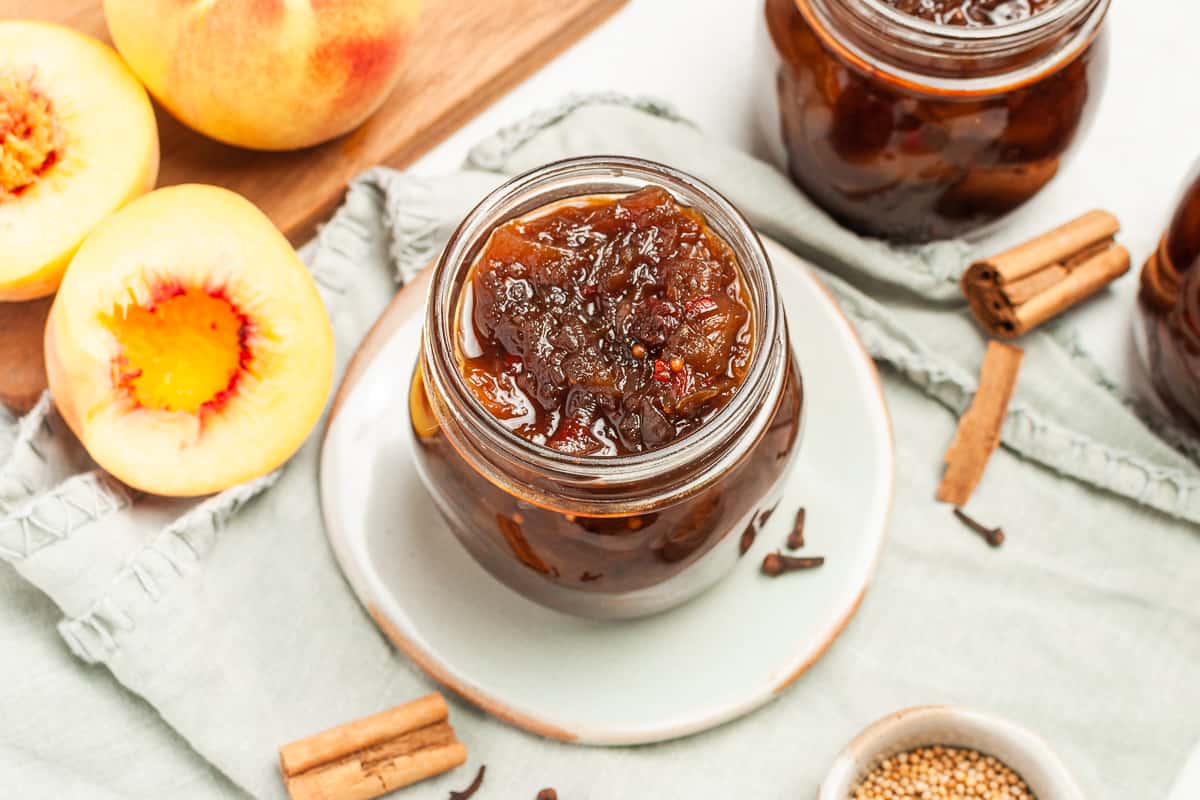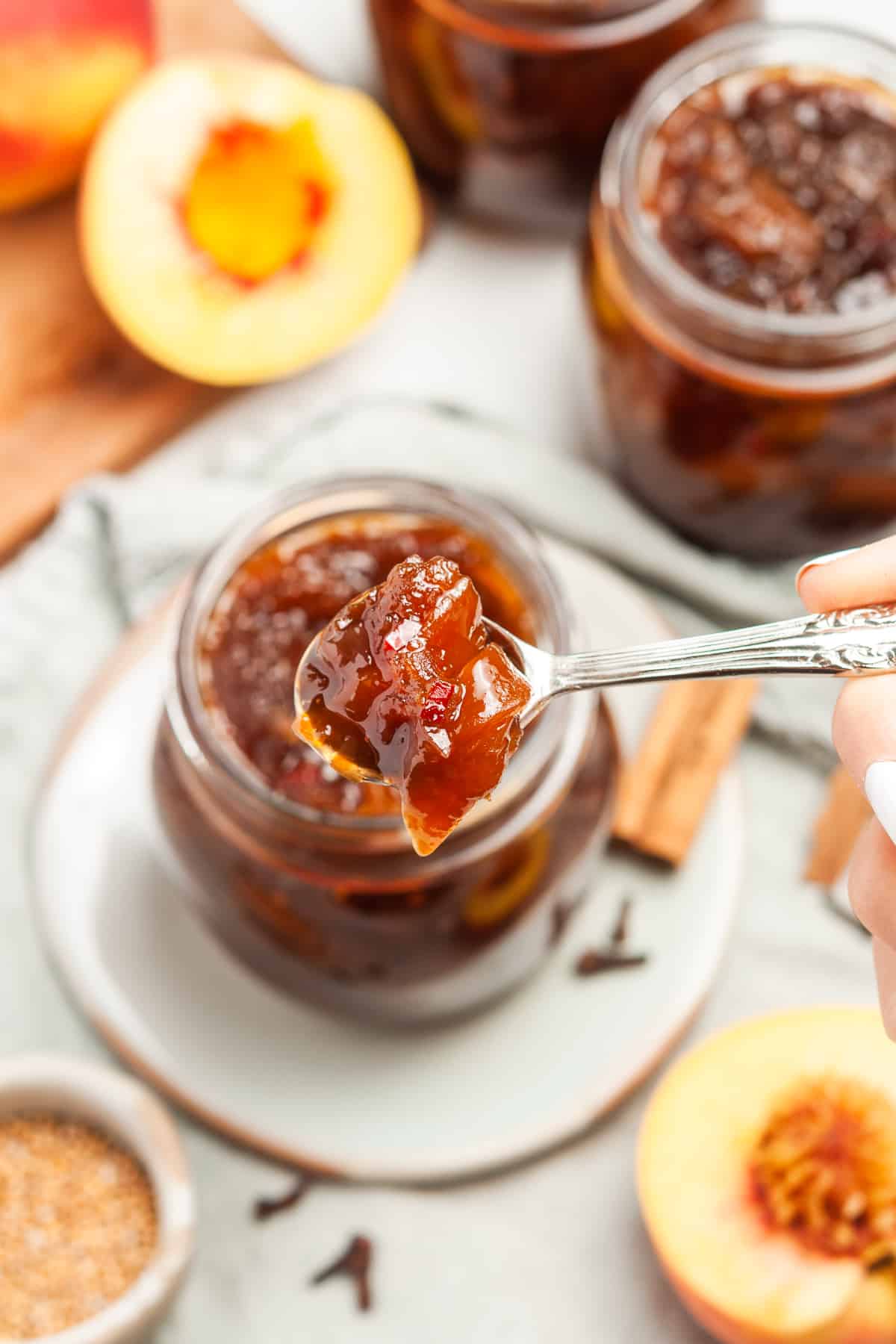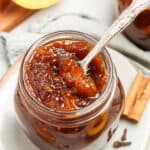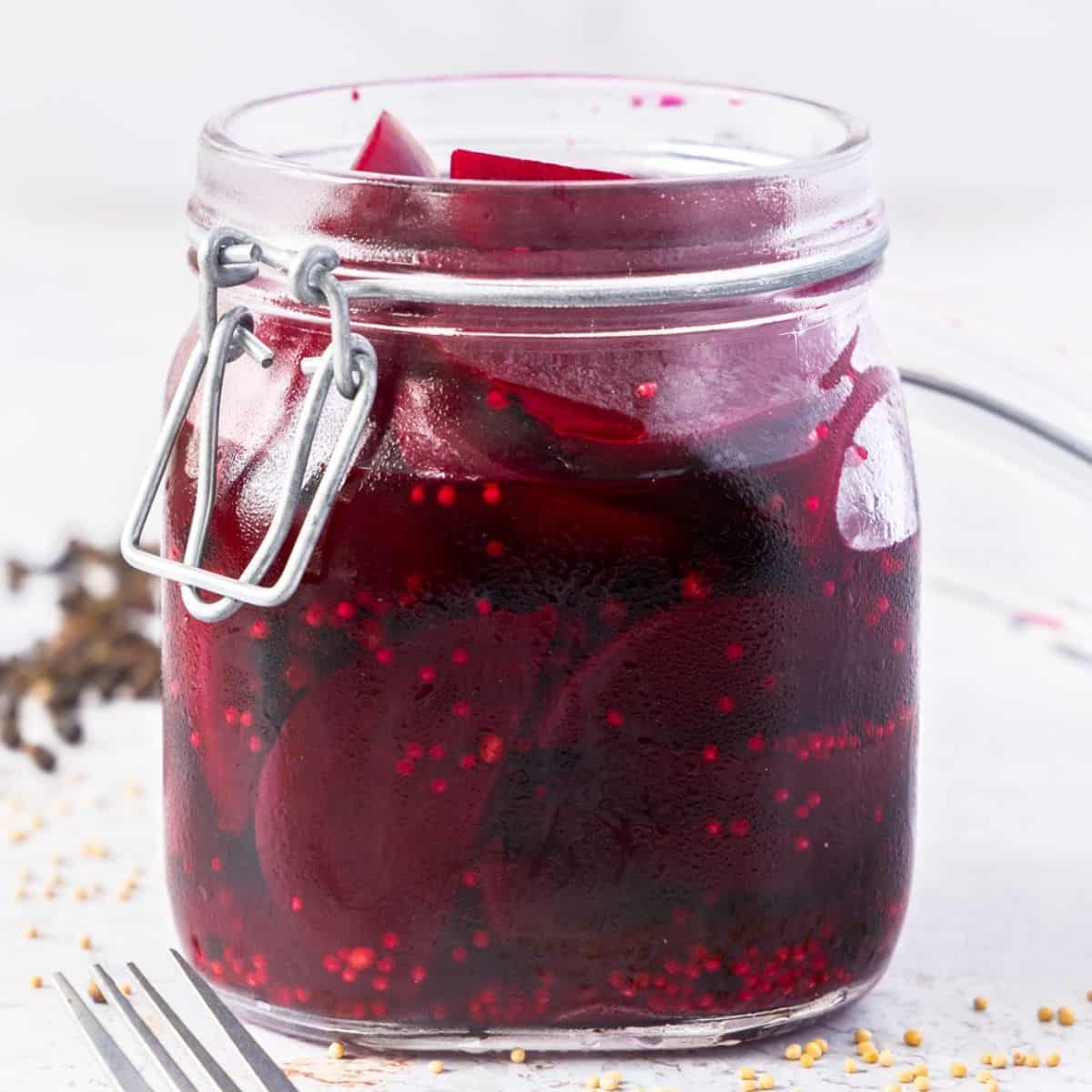My homemade Fresh Peach Chutney is a versatile, gently spiced condiment that goes perfectly with many foods. When peaches are in season, I like to use them in as many ways as possible. So, if you find yourself with an abundance of fresh peaches, this is a great way to preserve some.

Jump to:
Why we love this recipe:
Homemade chutney is a real treat and this is a great way to use peaches when they are in season. With jars of this spicy peach condiment on your shelves, you will have the satisfaction of knowing you have preserved seasonal fruit to use throughout the year.
As well, when you make something yourself, you have total control over the quality of the ingredients. There will not be any artificial colours, flavours or preservatives. Just pure, natural ingredients.
There are so many ways to enjoy this Fresh Peach Chutney:
- It perfectly complements roast chicken or grilled pork, works beautifully on a hamburger and is delicious in a toasted cheese sandwich.
- Add it to a ploughman's lunch platter or serve with antipasto.
- This flavourful, Fresh Peach Chutney also adds a bright note to turkey or beef sandwiches.
This is a versatile recipe; you can adjust ingredients to suit your taste or what you have on hand:
- If you don't have peaches, you could use nectarines or apricots.
- You could change the spices to suit your taste, perhaps adding some turmeric, garlic or freshly grated ginger.
- If you would like it extra spicy you could add some dried chilli flakes or cayenne pepper.
- Brown or white onions could replace the red onion used.
Ingredients in this recipe:

Please see the recipe card further along in the post for exact quantities of ingredients and the full method.
Fresh peaches - I have used yellow peaches but you could also use white. If possible, choose freestone. As the name implies, the stones in freestone are easily removed as opposed to clingstone varieties where you will need to cut around the stone.
Brown sugar - adds rich colour and flavour to the chutney.
Cinnamon stick - adds flavour and is easily removed when finished.
Yellow mustard seeds - they are milder than the brown variety but still add gentle spiciness.
Ground ginger - this is a warm, gentle spice with a touch of sweetness.
Cloves - we use whole cloves. This is a warm spice with an intense flavour.
Sultanas/golden raisins - these are dried, white, seedless grapes.
Sea salt - use coarse kitchen salt. Do not use table salt; it is very fine and will be too salty.
Long red chillies - these are also known as cayenne chillies.
Apple cider vinegar - made from fermented apple juice.
Granny Smith apples - a slightly tart apple, it perfectly complements the spices.
Medium red onions - these are milder and sweeter than the brown/yellow onion.
Step by step instructions:


To begin, we sterilise the jars. Full details are in the recipe below.
- To make the Peach Chutney, place the peaches into boiling water for 20 seconds.
- Then, place in an ice bath. Peel the peaches, cut them in half, remove the stone and then cut the flesh into large chunks.
- Place the peaches and the remaining ingredients into a large, non-reactive saucepan or stockpot.
- Stir over medium-high heat until the sugar dissolves.
- Bring the chutney to boiling point and boil vigorously for one hour, stirring from time to time. After one hour, remove the saucepan from the heat and stand for 10 minutes to allow the fruit to settle. Remove and discard the cinnamon stick.
- Remove your sterilised jars from the oven, and whilst they are still hot, fill with the chutney.
- Seal the jars immediately.
- Allow the flavours of the chutney to develop and enjoy.

Equipment Needed:
When making your own preserves, always ensure you are sterilising the jars you will store them in. This is very simple to do:
- Choose glass jars with an airtight, metal lid and ensure they have been washed in the dishwasher or by hand in hot soapy water then rinsed well.
- Check that the metal lids do not have rubber inserts, as these could melt in the oven.
- Preheat the oven to 130 Degrees C (270 F) and leave the jars for 15-20 minutes.
Use recycled glass jars with metal lids that are in good condition or purchase new ones.
You will not need any special equipment to make this recipe. You need a large, wide saucepan. Avoid aluminium, copper or iron pans; the acid in the fruit may react with the pan, giving the jam a metallic taste.
As well, I use a long-handled wooden spoon to keep my hand away from the bubbling chutney.

Tips for success and FAQs:
To obtain the best flavour from spices, they need to be fresh. Old spices will have lost some of their flavour.
I have used yellow peaches but you could also use white. This Fresh Peach Chutney is best when made with ripe peaches, but you can also use slightly underripe or slightly overripe fruit for this recipe. If the peaches are blemished, just remove the blemishes and imperfections and proceed.
A preserve made with vinegar needs time to mature. Set it aside for a minimum of one week, ideally two-four weeks. This will allow the flavours of the chutney to amalgamate and the vinegar to mellow.
When the jars have been properly sterilised and the chutney prepared according to the recipe, it is shelf-stable for up to one year. Store the sealed jars in a cool, dark, dry location. When opened, store the jar in the refrigerator. To prevent bacteria from developing, always use a clean, dry spoon to remove chutney.

More delicious recipes for you to try:
We absolutely love making the most of in-season produce to enjoy all year round. Here are some more of our favourite preserve recipes:
- Apricot Jam
- Preserved Chillies in Oil
- Lemon Marmalade
- Sweet Chilli Sauce
- Grapefruit Marmalade
- Easy Plum Jam
My Fresh Peach Chutney is a great way to make the most of summer's bounty. You will find many ways to enjoy it. Or, tie a pretty ribbon around the neck of a jar and give some as a gift.
Alex xx
This post was originally published in January 2019. It has been updated with new photos and more information. The recipe remains the same.

Fresh Peach Chutney
Please note:
For accuracy, when weights are provided, we recommend weighing your ingredients. This will produce the best results. All oven temperatures listed are for fan forced.
Ingredients
- 1 ½ kg (3.3 lb) peaches See Note 1
- 3 ¾ cups (750 gm) brown sugar
- 1 cinnamon stick
- 1 teaspoon yellow mustard seeds
- 2 teaspoon ground ginger
- 8 whole cloves See Note 2
- ½ cup (90 gm) sultanas/golden raisins
- 2 teaspoon sea salt
- 2 long red chillies - seeds removed and finely chopped See Note 3
- 3 cups (750 ml) apple cider vinegar
- 2 Granny Smith apples - unpeeled and grated
- 3 medium red onions - finely chopped
Instructions
To sterilise the Jars:
- Preheat the oven to 130 Degrees C (270F).Use glass jars, either new or recycled, with an airtight, metal lid. If recycling jars, ensure that the jars do not have cracks or chips and the lids are in good condition. Discard any lids that are pitted or rusted. Wash the jars and lids. If washing by hand, use hot, soapy water and then rinse them well. Alternatively, wash them in the dishwasher. Place jars and lids on a baking tray. Heat in the oven for at least 20 minutes. See Note 4.
To make the Chutney:
- To peel the peaches, half fill a medium sized saucepan with water and bring it to the boil.Meanwhile, prepare a medium sized bowl of iced water.
- Make a cross incision on the base of the peaches and place them in the boiling water for approximately 20 seconds.
- Remove the peaches with a slotted spoon and place in the iced water bath to stop the cooking process.Remove the peach from the iced water when it is cool enough to handle. Use a small, sharp knife to peel the skin. It will easily peel off.
- Cut the peach in half, cutting around the pit using the natural indentation of the peach as a guide. Gently twist the halves in opposite directions to separate them.Carefully remove the pit with a sharp, pointed knife and discard the pit. Remove any bruises.
- Cut the peaches into large chunks. (About 2.5cm or 1 inch)
- Place all the ingredients into a large, non-reactive saucepan or stockpot. See Note 5.Stir over medium-high heat until the sugar dissolves.
- Bring the chutney to boiling point then allow it to simmer for approximately 60 minutes.Stir occasionally until the mixture has reduced in volume, the surplus liquid has evaporated and the mixture thickens. The simmering time may vary as it will depend on the size of the pan and the amount of heat applied. As it thickens, you will need to be diligent with stirring and watch that it does not catch on the bottom of the pan. You can check that the chutney is ready by sliding a wooden spoon across the surface of the mixture. It is ready when the chutney does not immediately fill the gap. If the chutney is still too runny, cook it a further 5 minutes and test again.
- Be aware that as the liquid reduces, the mixture may bubble and spit and you need to take great care. I suggest that to be on the safe side, you wear a garment with long sleeves to protect yourself and use a long handled wooden spoon.
- After one hour, or your chutney has thickened as per above, remove the saucepan from the heat and stand for 10 minutes to allow the fruit to settle. Remove and discard the cinnamon stick.
- Remove your sterilised jars from the oven, and whilst they are still hot, fill with the chutney and seal the jars immediately.
- When the jars are cool enough to handle, remove any spills on the outside of the jars and label and date the chutney. Store it in a cool, dark, dry location. The chutney will keep for about one year. (See Note 6.)Set it aside for a minimum of one week, ideally two-four weeks. This will allow the flavours of the chutney to amalgamate and the vinegar to mellow.When removing chutney, always use a clean, dry spoon to avoid spoilage. Being extra cautious, I always store a jar in the fridge once it is opened.
Notes
- This is the weight of the peaches before the stones have been removed. I have used yellow peaches, but you could also use white peaches or nectarines. If possible, choose freestone peaches over the clingstone varieties. As the names imply, the stones in freestone are easily removed but with clingstone, there is a little waste as you will need to cut around the stone.
- You could use ½ teaspoon of ground cloves.
- The long red chillies are also known as cayenne chillies. If you don't have chillies, you could add dried chilli flakes or cayenne pepper to your taste.
- Properly sterilising your jars is an essential process to remove bacteria that could cause your preserves to spoil. Wash the jars and lids either in the dishwasher or by hand in hot soapy water, and rinse well. Do not dry them with a tea towel. Place jars and lids on a baking tray. If you are using Kilner jars with rubber seals, be sure to remove the seals before placing the jars in the oven. The dry heat of the oven would damage the seals. Boil the seals separately in a saucepan for about 10 minutes. Heat the jars in the oven for at least 20 minutes. When your preserves are ready to bottle, use thick oven mitts or jar tongs to remove the jars. Do not place them on a cold surface as they may shatter. I place mine on a wooden chopping board which I cover with a tea towel. Always sterilise a few more jars than you think you will need. It is better to have too many jars than not enough.
- Non-reactive saucepans are stainless steel, glass or enamel. Aluminium, copper and iron pans are reactive. Acidic ingredients, such as vinegar, may cause the chutney to discolour and take on a metallic taste if cooked in reactive pans.
- A preserve made with vinegar needs time to mature. Set it aside for a minimum of one week, ideally two-four weeks. This will allow the flavours of the chutney to amalgamate and the vinegar to mellow.
- Please note, the nutritional information is based on one whole jar. The nutritional information is an estimate only.
Nutrition Estimate:
Nutritional Disclaimer:
The nutritional information is an estimate only, and is derived from online calculators. For accurate results, we recommend calculating the nutritional information based on the ingredients and brands you use.















Natalie says
Hello!
I have an abundance of plums - have already made your Easy Plum Jam which was amazing! Wondering if I can adapt this peach chutney recipe to use it with plums instead?
Alexandra Cook says
Hi Natalie! 🙂
I am so happy you enjoyed the jam!
I do think you could adapt this recipe - but!
I am actually going to be publishing my Plum Chutney recipe very soon - hopefully in a couple of days time.
If your plums can hold out to then, keep an eye on the blog! Otherwise, feel free to send me an email, and I'll get you an advanced copy of the recipe before I publish it. Alex xo
Anne says
Fantastic chutney. I am just making my 4th batch! I made some as Christmas presents and everyone said how good it was, some even asking for the recipe so it must of been ok!
Thank you
Alexandra Cook says
Thank you, Anne! Fourth batch - that is fantastic 🙂
Appreciate you taking the time to leave a comment. Alex xo
Jennie says
So glad I found this recipe! I had already made more than enough jam and we just couldn't eat any more fresh peaches from our tree. I made this chutney and gave to friends for Christmas. it's been a huge success. I'm going to try to make some more with the rest of the peaches i have frozen (already skinned and pitted). Hope it still tastes as good.
Alexandra Cook says
Thank you so much for trying this recipe, Jennie!
So happy it's been enjoyed 🙂 Let me know how you get on with the frozen peaches!
Alex xo
Lisa says
I used the last of the peaches from my tree for this chutney. After 3 batches of peach jam, peach muffins, peach Tarte Tatin, 2 peach cakes and a peach galette it was time to try something different.
I’ve just scraped the remains from the cooking pan and they were delicious so I can’t wait to taste it again in a few weeks.
Thanks so much for the recipe!
Alexandra Cook says
Hi Lisa,
Wow - that is a lot of different and delicious ways to enjoy peaches.
I really appreciate you giving our chutney recipe a try! Thanks for taking the time to comment.
Alex xo
Malarvily says
Recently I received a box of fresh peaches from a friend. Not sure what to do till I saw your awesome recipe. Truly an awesome recipe! I replaced yellow mustard to black mustard as it is not easily available in Malaysia. I boiled it vigorously as you said and it thickened within an hour.
Thank you for sharing the wonderful recipe.
Alexandra Cook says
Thank you so much for making the recipe, Malarvily!
I am so happy you enjoyed it 🙂 Thanks for taking the time to let me know, Alex xo
Bryan Coulter says
Our peaches were so cheap at the moment so I tried to give this yummy recipe a go. It worked out so well and tastes so delicious. We have a brand called Mrs Balls Chutney in South Africa and I can tell you this recipe is way way more delicious and 1/3 or the price.
Alexandra Cook says
Hello Bryan,
Thanks so much for giving this recipe a try! I am so pleased that you enjoyed it so much, and really appreciate you taking the time to let me know.
Thanks again 🙂 Alex
Roxanne says
Hey! I want to use up some canned peaches I canned last summer- and this just looks delicious ! What do you think for using them in this? Maybe require some extra boiling down?
Alexandra Cook says
Hi Roxanne 🙂
Thanks so much for your question!
That isn't something I have tried before, but I don't see why it wouldn't work. If you give it a try, I'd absolutely love to know how you get on as other readers might have the same question.
Thanks! Alex xo
Dagta says
I just made a batch of this chutney - delllicious !
Have a couple of questions: the yield was about 8X 250 mL jars ! Should I have boiled it down more ? Boiled for about 1 h 45 mins, and the chutney was still a bit ‘watery’.
Alexandra Cook says
Hi Dagta,
Hmm, that is most unusual - it sounds as though the chutney may need to have been boiled down more, but given you boiled it for 45 minutes longer, I an uncertain why it would still be watery.
Did you make any changes to the recipe or add additional fruit etc?
The chutney should be concentrated and a sticky jam like consistency - and the water evaporated.
Would you say you vigorously boiled the mixture?
I am glad that you find it delicious - keep in mind it should be set aside for some weeks to really allow the flavours to develop now 🙂 (See Step 11.)
If you are concerned that it is too watery once it cools, you could rapidly boil it again for 10 minutes or so.
You may like to store the jars in the fridge also, as if it is too watery, this could cause the chutney to spoil.
Without being with you in the kitchen, it's hard to say exactly, so these are just some thoughts to help.
Thanks so much for trying the recipe! Alex xo
Debbie Bond says
Recently I had an excess of fresh peaches and came across this recipe which yielded 8 jars (small-medium). The taste test was awesome. So much so, that the chutney has not been left for the recommended four weeks. My significant other has consumed three jars already. It compliments almost everything from a cheese board to a topping for sausages and steak. Wonderful recipe so thank you... I will definitely be making this one again!!!
Alexandra Cook says
Hi Debbie!
Thanks so much for your lovely comment - I am thrilled to hear that you have been enjoying the chutney so much, and will make this recipe again. Thank you for taking the time to let me know 🙂 Alex
Chris says
Fantastic best chutney ever !
Alexandra says
Thank you, Chris!
So pleased you enjoyed it, and really appreciate you taking the time to let me know 🙂
Amy says
I really enjoyed making this peach chutney and it is absolutely delicious. This recipe is so easy.
Alexandra says
Hi Amy, I am so pleased that you enjoyed the Peach Chutney. Thank you so much for letting me know. 🙂
Jan says
This is such a great recipe. Simple to prepare, and the chutney tastes just fantastic.
I have made it twice now, and hoping to make one more batch before the season ends. Will be gifting some over the holidays!
Alexandra says
Hi Jan, thank you for your fantastic feedback on the Fresh Peach Chutney. I am delighted that you enjoy it and appreciate that you took the time to let me know. 🙂
Larry says
Really good recipe, but very vinegary in flavor. I wish I had used at least one less cup.
Alexandra says
Hey Larry!
Have you let the chutney sit for some time? At least a week, but the flavour will be at its best from the four week mark. The vinegar flavour will become more mild as the chutney matures.
Thanks, Alex
Liz says
I have so many peaches and was thrilled to find your recipe. This chutney is absolutely scrumptious!!
Alexandra says
I am so happy to hear this, Liz! Thank you so much 🙂
Layla says
Question: These don’t have to be canned in a warm bath? I just made tomato chutney that required it. Just want to be sure.
Alexandra says
Hi Layla, the recipe was developed to be shelf stable for 12 months, but you could can it if you prefer. 🙂
Wendle says
Easy recipe and great taste.
Alexandra says
Hi Wendle, I am so pleased that you enjoyed the Chutney, thank you for taking the time to let me know. 🙂